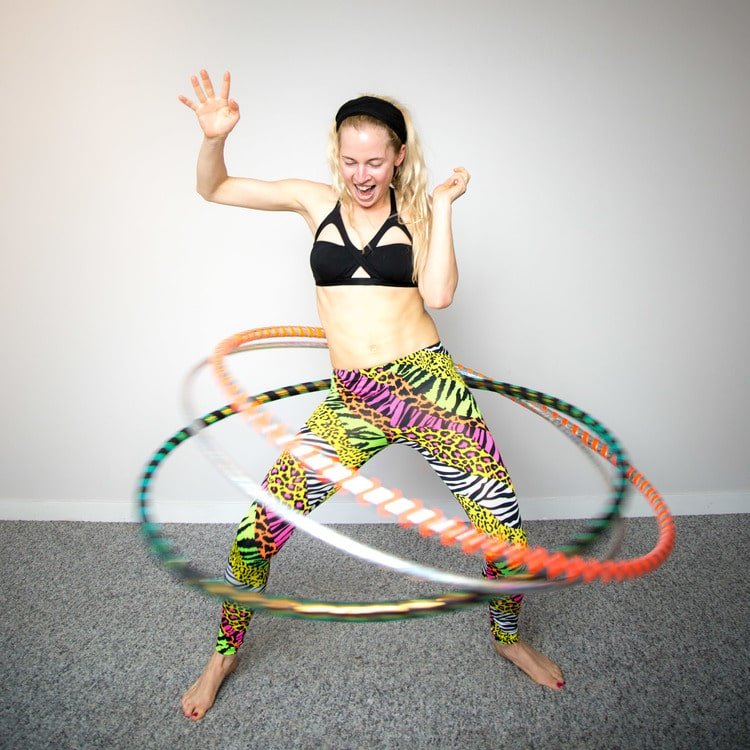The beginner's guide to hoop types and sizing.
A common challenge that beginner hula hoopers face is choosing the right hoop size. With so many options on the market, it's easy to become overwhelmed when searching for a hoop.
In general, you will need a bigger, heavier hoop to learn on-body hooping, and a smaller, lighter hoop to learn off-body tricks and skills.
We've included several conversion charts in this article that you can refer to when choosing the best size for a beginner hoop relative to your height and body type.
There are a few things to consider before selecting your first hoop.
What is your familiarity with different hoop sizes?
Are you interested in on-body hooping, off-body hooping, or both?
Do you have plenty of space where you will be hooping?
Do you have a limited budget?
Once you've determined your needs, you can start finding a hoop, or hoops, that work perfectly for you. If you have any questions, most hoopsmiths will be happy to help you decide. Feel free to contact us if you are a beginner and have any questions about our products that are not answered in this article.
Sizes of Hoops
There are two different size factors you need to consider when selecting a hoop: thickness and diameter.
Thickness refers to how wide the tubing is - is it the size of your finger, or is it closer to a bicycle handle? Different tubings used for hula hoops have different thicknesses - ½”, ⅝”, ¾” 11/16”, ⅞” and 1” are the thickness options you will see on hoops produced in Canada and the USA.
Diameter refers to how big across the hoop is. Polypro dance hoops are generally 24 - 36” in diameter. Big adult body (fitness/exercise/weighted) hoops are generally 38 - 48” in diameter.
Types of Tubing
You will see a few different types of tubing mentioned in the descriptions of hoops for sale in the GeoRev shop. Below is a quick breakdown of what they are.
HDPE - The large thickness (⅞” and 1”) is used by savvy hoopsmiths to create heavier, “weighted” body hoops for adults in the 38 - 48” range. These hoop tubings have thick walls which adds weight.
Small HDPE hoops - The smaller ⅝” and ¾” HDPE tubings do not have thick walls and are sold as an alternative to lightweight polypro dance hoops. They are about one ounce heavier than an equally sized polypro hoop. Small HDPE hoops may be chosen over polypro because they are extremely resistant to snapping in cold weather - cold temperatures do not affect them, unlike hoops made with polypro tubing. However, HDPE hoops are “stiffer” than polypro hoops - they just feel a little different.
Polypro - Common abbreviation for hoops made from polyproplene tubing. This tubing is lightweight, reactive and bouncy. It comes in 5/8”, 11/16” and 3/4” thick. Polypro hoops are typically sold in the 19-36” diameter range. This is the hoop of choice for most hoop enthusiasts.
PEX - known as the “poor man’s polypro” this tubing is very durable and medium weight irrigation tubing that can be found at any hardware store. It is approximately 5/8” thick. It’s great for making kids hoops, or an off body adult hoop if you have a limited budget.
Adult Hula Hoops
WE CAN EXCHANGE THE TERM “ADULT HULA HOOP” WITH “BEGINNER HOOP”, “WEIGHTED HOOP”, “FITNESS HOOP”, AND “EXERCISE HOOP” - THEY ARE ALL PRETTY MUCH THE SAME THING! ADULT HOOPS ARE DESIGNED FOR ADULTS TO BODY HOOP WITH AND ARE LARGER AND HEAVIER THAN HOOPS DESIGNED FOR CHILDREN.
GeoRev beginner body hoops are usually made from ⅞” or 1” HDPE which is heavy enough to slow the hoop down and help you learn, but not so heavy that it will bruise you or hurt your spine during your workout session. These hoops weigh in at 1-2 lbs. Anything heavier can hurt you and make it harder to transfer your skills to smaller, lighter hoops in the future. The bigger the hoop diameter, the easier it will be for you to learn body hooping skills, especially in the reverse direction!
Note: Beginner body hoops can also be made from 11/16” Polypro tubing, for very small or very athletic people.
Most beginners are advised to get weighted hula hoops, because the first association people have with hula hooping is waist hooping. Heavier hoops are ideal for getting the body accustomed to the gyrating motion of on-body hooping if you haven't swung your hips in years (or ever). A heavier hoop is great if you're just learning how to body hoop on your waist, chest, shoulders, and knees.
Many companies sell beginner/fitness/exercise hoops that are overly weighted. It’s a common misconception that you need a very heavy hoop weighing over 2 lbs to get good results. These stiff, heavy hoops (typically made from black polyethylene tubing) are uncomfortable to use, and can cause bruising to the torso and spine. GeoRev beginner body hoops are made of materials that are perfectly sized and weighted for adults to use for exercise and minimize discomfort and injury.
Small and/or very athletic people and/or experienced hoopers can body hoop with smaller HDPE or polypro hoops. Most adults need a much larger, heavier body hoop made out of HDPE or 11/16” polypro to learn and perform body hooping. Even advanced hoopers will need a larger, heavier hoop to learn the most challenging on-body moves.
You can use the conversion chart below for our general recommendations based on years of experience teaching beginner on body hoopdance and sizing customers in person. Remember, a bigger hoop will be easier to use, but take up more space.
All hoops meant for on-body use should have grip tape, preferably 3M Grip.
Polypro dance hoops / Professional dance hoops
When people get really into hooping, they inevitably gravitate towards lightweight polypro hoops. A smaller polypro hoop can be manipulated in ways that a large body hoop just can’t. There are thousands of tricks and movement combinations you can learn with a polypro hoop. Adding your own personal way of moving with a polypro hoop and developing your own style makes hoop dance an infinitely entertaining hobby.
Hoops for kids are commonly sold in dollar stores and by other large corporations. The problem with these hoops is that they are mass produced in China using flimsy plastic. Dollar store kids hoops look appealing but don’t hold up to much actual use, which is why you always see them broken. It is a much better idea to get your child a hoop handcrafted by a professional hoopsmith. A professional hoop maker uses sturdy irrigation tubing and solid connection hardware to create a hoop for kids that has the most important property - durability. Kids love to roll, tug, toss and play with hoops, in addition to body hoop with them. GeoRev Kid Hoops are made out of the perfect material (½” PEX tubing) for children to use and abuse. These hoops are smaller and lighter weight than adult body hoops, and can also be used for an adult to practice off body hooping with!
Note: Although they are all lightweight, PEX is superior to polypro or HDPE tubing for childrens hoops in most circumstances, due to its exceptional flexibility and strength. If your child is a gymnast or very serious about hoopdance and will not be abusing the hoop, you can get them a small sized polypro hoop.
Travel hula hoops
Did you know that most hoops are collapsible, and can fold down to ⅓ or less of their original size? That’s how they are shipped, and it also makes them convenient to travel with. We also create sectional hoops, which break down into multiple pieces. Yes, we can make a hoop small enough to fit inside a backpack or purse.
Multi Hoops
Multiple on-body hooping with 2-6 hoops, or circus style hooping, is accessible to beginner/intermediate hoopers who want to learn and have basic body hooping skills (waist, chest and knees). You want matched, large diameter 11/16” polypro hoops with grip tape for this. (The regular 1” HDPE beginner on body hoops are too big to use several with comfort). We recommend sets in 32 - 36” for small, experienced or extremely athletic people, 36-40” for medium sized people, and 40-44” for large people. Learning to hoop with multiple hoops on body is much harder than single hooping, so you should always get the largest size you are comfortable with to ensure success.
Mini Hoops
Typically, mini hoops are two small polypro hoops used to learn and perform off body double moves. Polypro hoops for off-body doubles are matched and usually sized between 19 - 27”. As with any hoop, the larger ones are easier to learn on, while the smaller ones may be favored by advanced users for speed and style. Many intermediate and advanced hoopers also enjoy manipulating a single mini hoop.
LED Hoops
LED hoops, also known as “smart” hoops when they have an internal circuit board and multiple light patterns, light up the night and are a favorite of hoop enthusiasts and professional hoop performers alike.
Many beginners make the mistake of getting a cheap “light up” hoop off Amazon as their first hoop. When you are ready for an LED light up hoop, it will be after you have spent many hours of practice in a day hoop. The cheap ones are wonky and break right away. The more expensive LED smart hoops are somewhat durable but also prone to breakage when dropped repeatedly or even just from regular use outdoors, due to sensitive interior electronic components. Therefore, an LED hoop is something you should purchase for yourself after you have practiced a lot on regular hoops. *Note: LED hoops are not produced in Canada.
Fire hoops typically have spines with kevlar wicks extending the fire beyond the hoop by 5 to 8 inches to help keep the dancer safe while hooping. Fire hoops should not be used by beginner hoopers. You need to be able to perform many moves with accuracy and have a very good knowledge of recovery moves before getting your first fire hoop. Study fire safety before fire hooping, and choose a fire hoop with fewer wicks (3-4) if you are new to it.





